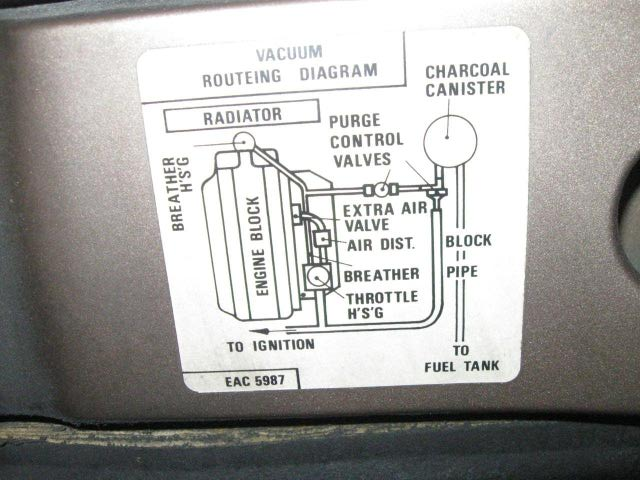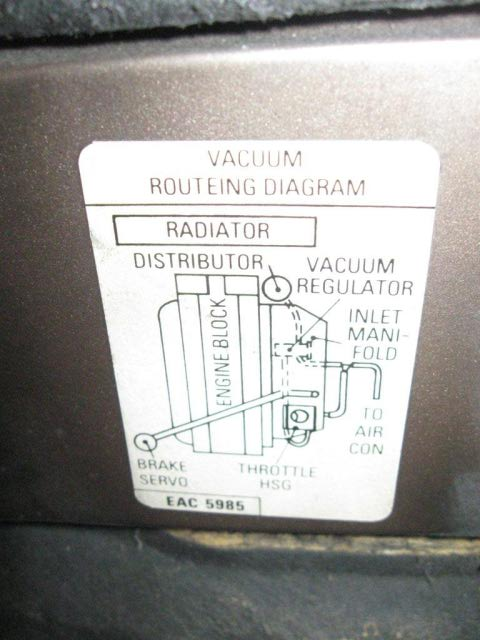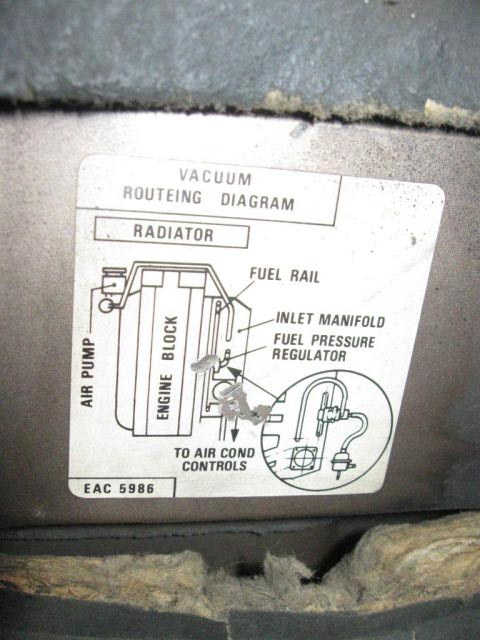Question Vacuum diagram 2
Vacuum diagram 2
 Vacuum diagram 1
Vacuum diagram 1
QUESTION: Howard,
Thanks for the vacuum diagram, I'll have to trace out my lines & check for leaks and see what I've connected to the distributor ! It seems to be ported since it rises with rpm. I had to bump up the idle to 1000 rpm, otherwise it keeps stalling when I put it into gear when it's cold. Now the car is running ok, stumbles when cold when I give it some gas - probably because it's too rich at that point. Once warm it's fine and seems a bit smoother than before. I'm going to back off the mixture screw 1/2 turn each day to see how the driveability is when cold, maybe I'll find a spot where it's good when cold. I'm using the car as my daily driver, I'd like to get the idle a bit smoother, especially when I'm crawling through traffic but the engine isn't new anymore, I think I may do a compression test to see what I can really expect from it. I found 3 vacuum stickers under my hood, I've attached photos of 2 them in case you're interested, let me know if you want the 3rd (can only attach 2 at a time here)
Thanks again Howard,
Steve.
ANSWER: I have never been able to get a series III car to idle very smoothly as compared to other Jags. I always felt that it was a poorly designed intake manifold as the cause. The only way I have been able to get one to idle smoothly was to lean the mixture out and then it wouldn't run just above idle very well.
Thanks for the diagrams as I do at times get questions from Canada and these diagrams may come in handy. If you have a 3rd do send it too.
I don't know if your cars have an O2 sensor but all the US versions do. Early ones have just a one wire O2 sensor and the later ones have a 3 wire sensor.
The O2 sensor produces a voltage when warmed up. So many mechanics here are able to use it to set the CO (mixture at idle). A .5v reading is ideal mixture. A .3v or lower is lean and a .7v to 1v is rich.
On the 3 wire sensor two of the wires are just an electric heated so the 3rd wire can still be used to adjust CO. On the 3 wire sensor the blue wire is the O2 sensor.
Howard
---------- FOLLOW-UP ----------
 Vacuum Drawing 3
Vacuum Drawing 3
QUESTION: Howard,
Interesting that the series 3 didn't idle well, being a luxury car. I could get the idle so smooth on my Spitfire I often thought it stalled so I'd look at the tach and realize it was still running ! My car has 'Federal' stamped on the side of the engine bay so I think it's very similar to a US car. It has the single wire O2 sensor, I replaced it last year when I bought the car. I've attached the 3rd vacuum drawing.
Thanks again,
Steve.
AnswerThanks for the 3rd diagram. You can then use the O2 sensor wire to check mixture. Warm the engine up first and disconnect the O2 sensor and connect a volt meter to the wire from the sensor and put the volt meter on a low volt scale so you can read 0 to 1 volt at idle. .5v is ideal.
I have two ser III cars of my own and use to get them from the local dealer after I retired. The Jag dealer would take them in on trade for several years but didn't want to put them on their lot so they would sell them to me and I just fixed up the details on them and sell them. I bought three in one day on a credit card once. I've always loved the ser III even though the body panels were coming from the factory in bad shape the last couple of years of production. The last year (87) they were so bad that the dealers had to send many to the body shop before they could put the cars on the showroom floor. The stamping dies were worn out and BLM was gearing up for the 40 series car and they didn't want to spend the money on new dies for the ser III.
They soon wished that they had because no one would buy the 88 40 series car because it looked just like a Chevy or Ford of that era. BLM in their infinite wisdom or rather lack of wisdom. Thought that because a lot of Americans bought Chevys and Fords that looked somewhat like a cracker box that they would love a Jaguar that looked like a cracker box too.
The people who could afford a new Jag wanted every one to know it was a Jag and not get mistaken for a Chevy or Ford.
Jaguar sales didn't pick up until they made it look like the series III again and then they added the "S" type with a grill like the old Mk II Jag. It also helped when Ford put their electrics in the Jags. I have not heard of how much if any influence TaTa of India has put into the new Jags. Almost no one in the US ever heard of TaTa until they bought Jaguar from Ford. But they seem to have a lot of technology in the auto and truck industry.
Howard


